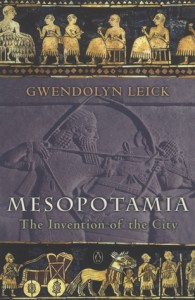The mythology of Mesopotamia revolves around the accouterments of civilization to a surprising degree. Maybe it’s because cities were founded so early in that region, sometime before 4,000 B.C.E. One myth even concerns itself primarily on how Inanna brought various technologies to her city of Uruk. Another myth describes how wild creatures were banished from a tree so it could be fashioned for Inanna’s throne. The most famous Mesopotamian myth, The Epic of Gilgamesh, concerns itself with the tensions between urban and rural life.
I just finished a book called Mesopotamia: The Invention of the City by Gwendolyn Leick that underscored for me the central place of the city in Mesopotamian religious life. Before the invention of cities, the gods lived in heaven, and they created dry land in the sea below with the idea of building a dwelling place for themselves. That dwelling was the temple, and the surrounding city, like humans themselves, was created to serve the needs of the gods in their home. Leike points out “Thus the Mesopotamian Eden is not a garden but a city, formed from a piece of dry land surrounded by waters.” The significance of this reason for creating earth is that “Contrary to the biblical Eden, from which man was banished for ever after the Fall, Eridu remained a real place, imbued with sacredness but always accessible.”
There have not been a lot of books about Mesopotamia in English published in the last twenty years that are directed toward a lay audience, and still fewer written by women. My interest in Mesopotamia is in religion from a feminist standpoint, and I have no interest in urban planning and still less in the dizzying history of war and conquest in this region. I trusted that my subject would be treated at least tangentially, and I was pleasantly surprised. This was a reminder yet again that you cannot understand the religion of a culture without understanding many aspects that our secularized society has designated nonreligious.
This is a book for people who have already read a bit about Mesopotamia. The material is dense, although clearly written, and there is a lot of politics that will not interest most people. The biases of the milieu Leick comes from are apparent, especially in the first few chapters where the dearth of evidence necessitates some speculation. Unlike many academic writers she does address issues of class, ethnicity, and women’s status, and she identifies places where religious texts are driven by political concerns. I recommend that novices start with Mesopotamian myth and poetry, such as that found in Gilgamesh: A New English Translation by Stephen Mitchell or Inanna: Queen of Heaven and Earth by Diane Wolkstein and Samuel Noah Kramer, which also has some introductory commentary. But if you’re ready to move on to some historical context, this is a book I would check out.
There is still time to sign up for my online course Emerging Interpretations of Inanna’s Descent.

